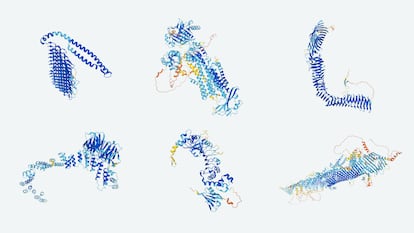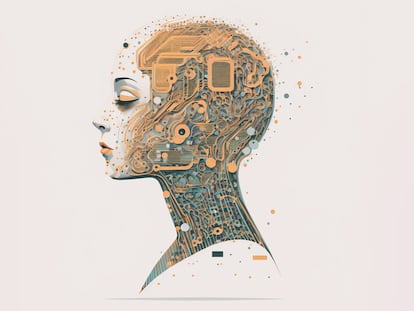The bright side of artificial intelligence
AI is a powerful tool for science and medicine

Now that everyone from Geoffrey Hinton to Elon Musk to Yuval Noah Harari has spoken out against ChatGPT, it seems like a good moment to remind us of artificial intelligence’s enormous potential for advancing knowledge and alleviating human suffering. I know my attitude may be annoying amidst the clamor against the perversity of machines and their effects on civilization, but the vulgar villains of James Bond have gone out of style. If artificial intelligence is going to be the bad guy, we must characterize it with its nuances and contradictions, its foreseeable objectives and its relevant skills, its political darker sides and, yes, its scientific lights.
Artificial intelligence’s greatest contribution to science has been AlphaFold, an algorithm by the London firm DeepMind acquired by Google years ago. To understand it, let’s review basic biology. There are 20 different amino acids, and all proteins consist of a string of them, in any order. The order, or sequence, determines the protein’s final form: some amino acids have positive electric charges and others negative; some like water and others don’t; some are big and some are small. All those attributes come together to form a defined three-dimensional shape, which is extremely difficult to predict. AlphaFold has deducted 200 million protein forms using amino acid sequences.
Now let’s take a look at protein design. There are 20 amino acids. The possible sequences of two amino acids are 20 squared, and for three amino acids, there are 20 cubed possibilities. The possibilities for a sequence of 300 amino acids —a typical protein— are 20 to the 300th power, a number that we can’t even imagine. Despite the fact that evolution has been working on this planet for almost four billion years, the fraction of sequences that have been attempted is miniscule. If politics is the art of the possible, biology is the art of the passable: when something solves the immediate problem at hand, evolution doesn’t look any further. But in the vast territories unexplored by Mother Nature lie treasures that artificial intelligence now puts at our reach.
Proteins, like the genes that code them, are texts, so they can be managed with the same large language models that ChatGPT uses. The computer scientist Ali Madani and his colleagues have shown how to use these language models to generate proteins with new sequences. Brought into the real world, they can be used for different purposes, like catalyzing chemical reactions or blocking natural proteins. A new algorithm called Chroma, from the company Generate, improves the predictions of long-distance interactions inside a single protein. There are half a dozen other companies working along the same lines.
Artificial intelligence is a powerful tool for science and medicine. Don’t shoot the robot. Watch over its owner.
Sign up for our weekly newsletter to get more English-language news coverage from EL PAÍS USA Edition
Tu suscripción se está usando en otro dispositivo
¿Quieres añadir otro usuario a tu suscripción?
Si continúas leyendo en este dispositivo, no se podrá leer en el otro.
FlechaTu suscripción se está usando en otro dispositivo y solo puedes acceder a EL PAÍS desde un dispositivo a la vez.
Si quieres compartir tu cuenta, cambia tu suscripción a la modalidad Premium, así podrás añadir otro usuario. Cada uno accederá con su propia cuenta de email, lo que os permitirá personalizar vuestra experiencia en EL PAÍS.
¿Tienes una suscripción de empresa? Accede aquí para contratar más cuentas.
En el caso de no saber quién está usando tu cuenta, te recomendamos cambiar tu contraseña aquí.
Si decides continuar compartiendo tu cuenta, este mensaje se mostrará en tu dispositivo y en el de la otra persona que está usando tu cuenta de forma indefinida, afectando a tu experiencia de lectura. Puedes consultar aquí los términos y condiciones de la suscripción digital.
More information
Archived In
Últimas noticias
Trump claims peace in Ukraine is near, but Moscow suggests otherwise
A survivor’s account of the Interoceanic Train accident: ‘We were scared because of the speed on the curve’
The Interoceanic Train, the Mexican alternative to the Panama Canal
What is known about the Interoceanic Train derailment in Oaxaca
Most viewed
- Oona Chaplin: ‘I told James Cameron that I was living in a treehouse and starting a permaculture project with a friend’
- Reinhard Genzel, Nobel laureate in physics: ‘One-minute videos will never give you the truth’
- Why the price of coffee has skyrocketed: from Brazilian plantations to specialty coffee houses
- Pablo Escobar’s hippos: A serious environmental problem, 40 years on
- Chevy Chase, the beloved comedian who was a monster off camera: ‘Not everyone hated him, just the people who’ve worked with him’











































